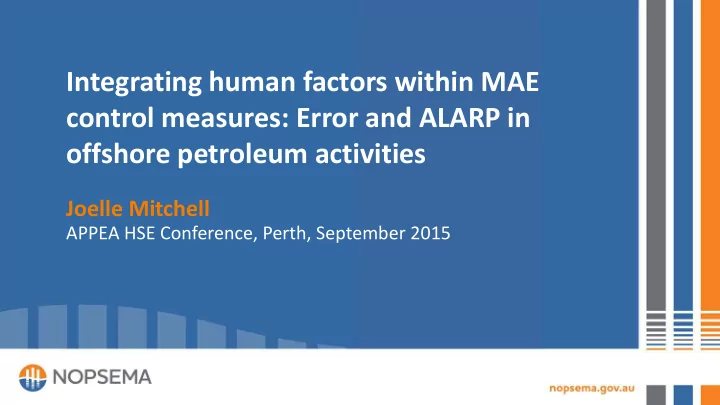

Integrating human factors within MAE control measures: Error and ALARP in offshore petroleum activities Joelle Mitchell APPEA HSE Conference, Perth, September 2015
Human Factors and MAEs • Humans interact with control measures • Error can be a barrier-defeating factor • Error risk can be addressed through adapted traditional risk management approaches A433199 08/09/2015 2
Reducing error risk Error Prevention Error Management A433199 08/09/2015 3
Typical approach Hazard Consequence Hazard Consequence Mitigation Prevention Training & Error EVENT Hazard Consequence competency Controls Controls Hazard Consequence Hazard Consequence Elimination Prevention Reduction Mitigation A433199 08/09/2015 4
A more accurate approach ! Error ! Error Control Control Control Control Control Control Control Control Control Control ! Error Control A433199 08/09/2015 5
A deeper exploration Performance shaping factor Performance shaping factor Mitigation Performance Prevention Control ERROR shaping measure Controls Controls factor failure Performance shaping factor Performance shaping factor A433199 08/09/2015 6
Example – Texas City Refinery • March 23, 2005 Isomerization unit start-up – – Operators overfilled the raffinate splitter tower – Pressure relief devices activated – Flammable liquid spurted from a blowdown stack – No flare installed – Ignition, explosion and fire – 15 deaths, 180 injuries A433199 08/09/2015 7
Error analysis Incorrect knowledge Fatigue Knowledge- Control Overfilling Misleading measure tower HMI based mistake failure Poor handover Insufficient personnel A433199 08/09/2015 8
Possible controls Incorrect knowledge Training Simulation Drills Fatigue FRMS Knowledge- Maintenance HF in Drills Tower HF in Misleading design Maintenance Tower overfill Overfill HMI based mistake design Trip Error training Comms conventions Procedure Poor handover Risk indicators Planning rules Insufficient personnel A433199 08/09/2015 9
Benefits of error analysis • Classify potential high-risk errors • Identify critical PSFs • Develop targeted control measures • Focus on prevention and mitigation • Facilitate risk reduction to ALARP A433199 08/09/2015 10
Which errors? • “Critical human tasks” • Activities people are expected to perform: – as barriers against an incident – to prevent incident escalation – to support or maintain barriers during an incident • OGP (2011). Human factors engineering in projects. A433199 08/09/2015 11
A suggested process Identify critical human tasks Develop Identify error additional potential controls Evaluate existing Identify PSFs controls A433199 08/09/2015 12
Identify critical human tasks Identify critical human tasks • Tasks where: Develop Identify error additional – a procedure is a single point failure potential controls – people interact with control measures – error can lead to barrier failure Evaluate Identify PSFs existing controls – barrier failure can lead to MAE A433199 08/09/2015 13
Identify error potential • Task analysis can help Identify critical human tasks – What errors are possible? Develop Identify error additional potential controls – Classify errors by a taxonomy – What are the potential consequences? Evaluate existing Identify PSFs – What are the high-risk potential errors? controls A433199 08/09/2015 14
Identify PSFs • People-level Identify critical – Knowledge, skills, experiences human tasks – Health Develop Identify error • Job-level additional potential controls – Procedures – Equipment Evaluate – Supervision existing Identify PSFs controls • Organisation-level – Culture & climate – Corporate strategy A433199 08/09/2015 15
Evaluate existing controls • Prevention controls? Identify critical human tasks Develop Identify error additional potential • Mitigation controls? controls • Is error risk ALARP? Evaluate existing Identify PSFs controls A433199 08/09/2015 16
Develop additional controls • Layered defences targeting error: Identify critical human tasks – Eliminate the opportunity Develop Identify error additional – Prevent the error potential controls – Reduce the impact – error identification and recovery Evaluate existing Identify PSFs – Mitigate the consequences controls A433199 08/09/2015 17
Where to start? • Evidence of uncontrolled error: – Events and dangerous occurrences – Existing controls have failed to mitigate error risk • Performance-shaping factors: – Latent conditions – Broader implications A433199 08/09/2015 18
Summary • Human error can facilitate barrier failure • Error is most significant within critical human tasks • Layered defences can reduce error risk • Effective risk reduction includes: – error prevention – error mitigation A433199 08/09/2015 19
Online resources www.nopsema.gov.au A433199 08/09/2015 20
Questions
Recommend
More recommend